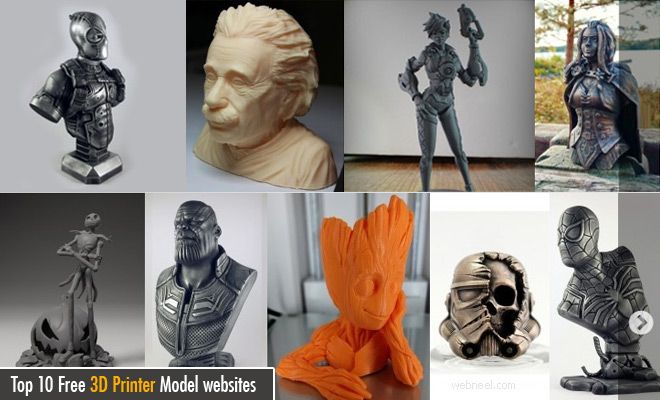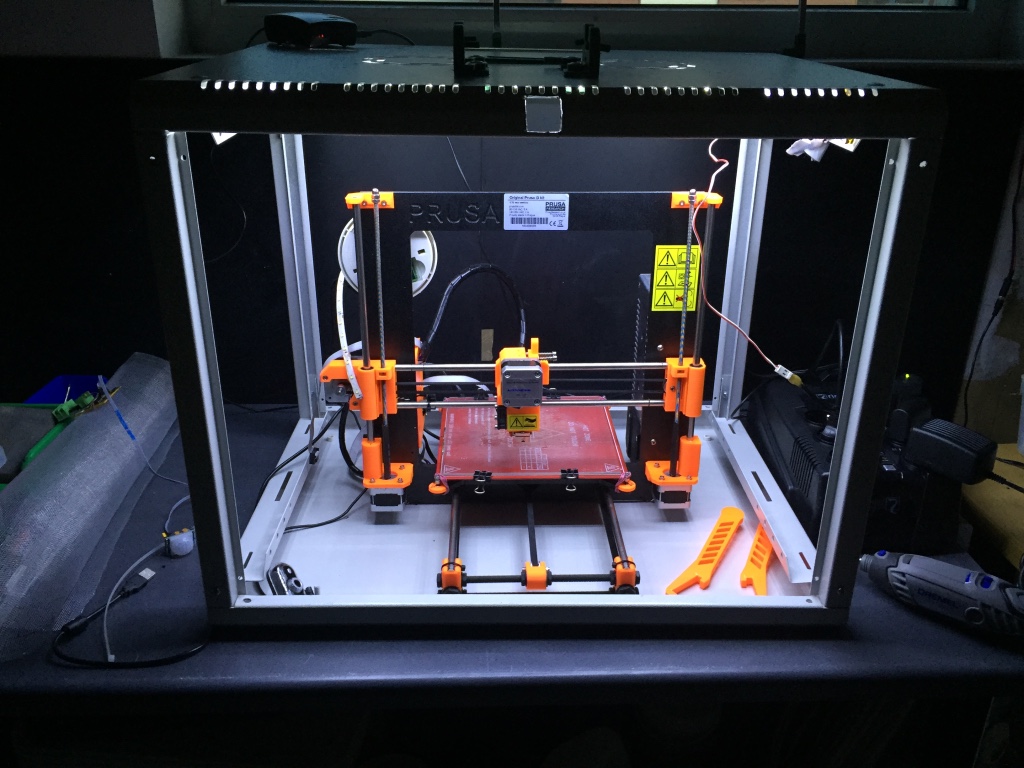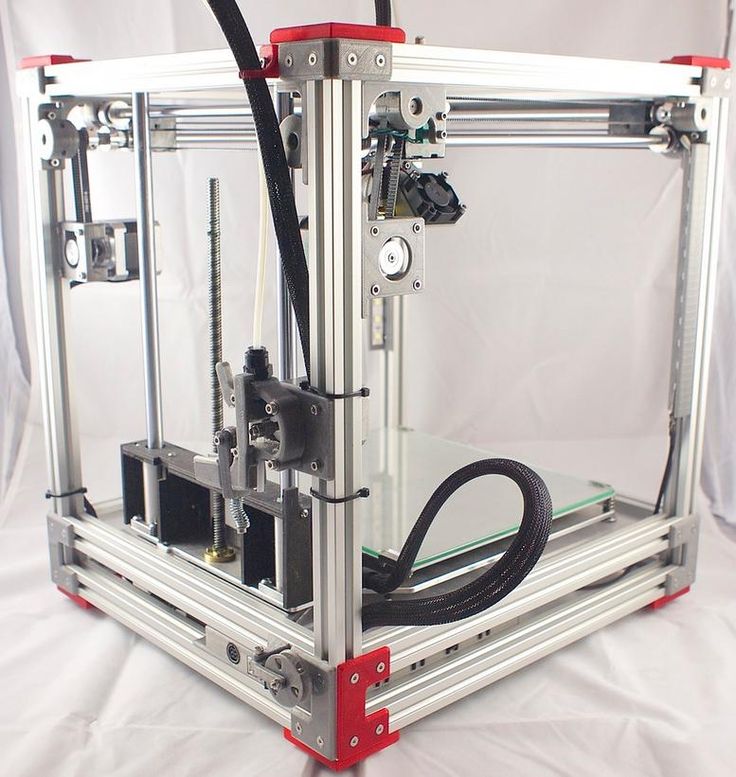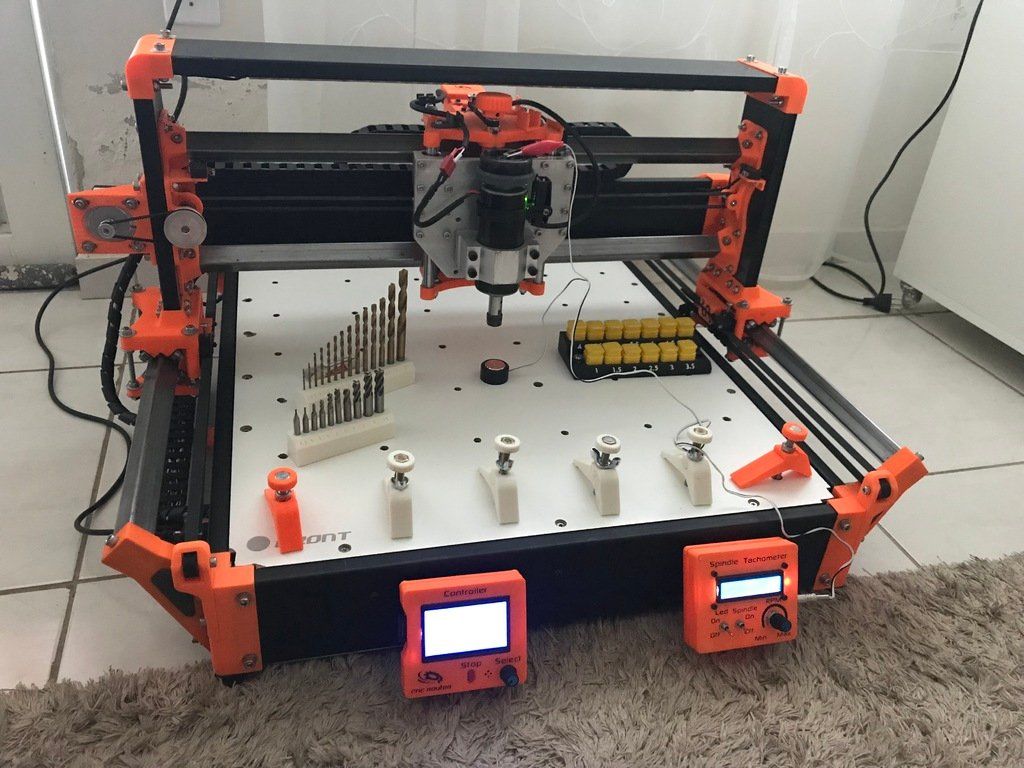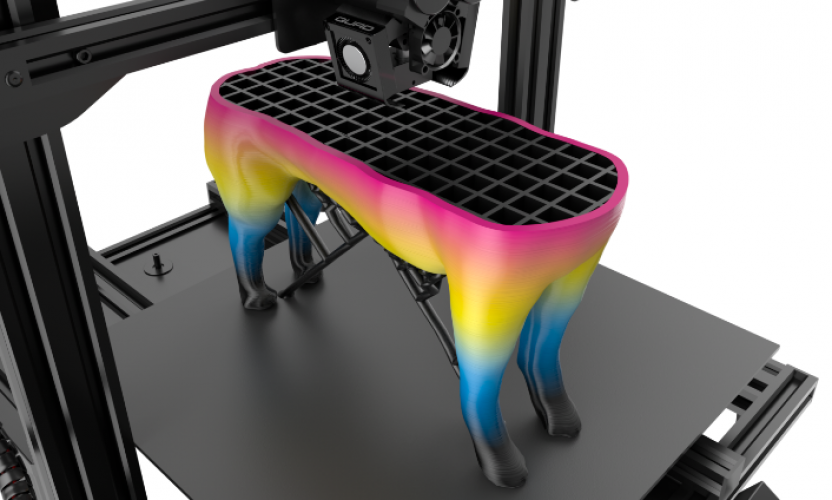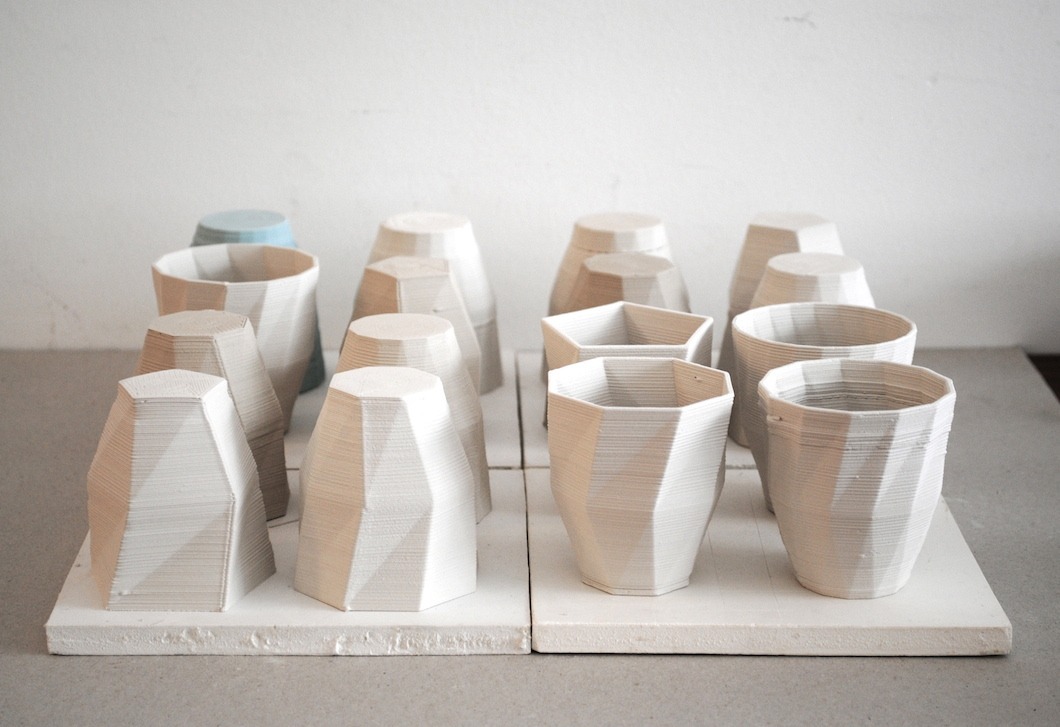3D printing polymer materials
3D Printing Materials Guide: Plastics
Published on June 8, 2020 by Alexandrea P.
A plastic is a material made of synthetic or semi-synthetic compounds that has the property of being malleable (capable of changing its shape). Most plastics on the market are completely synthetic (most commonly derived from petrochemicals). However, given the growing environmental concern, plastics derived from renewable materials such as Polylactic Acid (PLA) are also popular on the market. Due to their low cost, ease of manufacture, versatility and water resistance, plastics are used in a multitude of products and sectors. In the AM sector, 3D printing plastics are also very popular.
In the following guide, we will take a look at the most common 3D printing plastics. As you may know, the most popular and affordable 3D printing process, FDM, produces parts through the extrusion of plastic filaments. However, the precision on FDM machines is not the same as other AM processes such as SLS or SLA. Plastics are often used with this technology to create prototypes. Therefore, for industrial and end-use parts, manufacturers might decide to opt for SLS (using plastic powders) or SLA (using plastic resins) technologies that offer more accuracy and part quality. Two other technologies that can print with plastics are Material Jetting and Multi Jet Fusion.
What plastics can be used in additive manufacturing? In filament or powder form, the plastic should melt to form the object you are printing layer by layer. In resin form, it should solidify to form the object. Each plastic will require different 3D printing parameters during the building process, and will give parts varying properties.
ABS
ABS filament is the most commonly used 3D printing plastics. It is used in the bodywork of cars, appliances, and mobile phone cases. It is a thermoplastic which contains a base of elastomers based on polybutadiene, making it more flexible, and resistant to shocks. ABS can also be found in powder form for powder bed processes such as SLS, and liquid form for SLA and PolyJet technologies.
ABS is used in 3D printing when heated between 230ºC and 260ºC. It is a tough material, able to easily withstand temperatures of -20ºC to 80ºC. In addition to its high strength, it is a reusable material and can be welded with chemical processes. However, ABS is not biodegradable and shrinks in contact with air, so the printing platform must be heated to prevent warping. Moreover, it is recommended to use a closed chamber 3D printer to limit particle emissions when printing with ABS. Learn more about ABS in our dedicated guide.
PLA
Known as polylactic acid, or PLA, this material has the benefit of being biodegradable, unlike ABS. PLA is manufactured using renewable raw materials such as corn starch. PLA is one of the easiest materials to print, though it does have a tendency to shrink slightly after 3D printing. You don’t require a heated platform when printing in PLA, unlike with ABS. PLA also prints at a lower temperature than ABS, between 190ºC to 230ºC.
PLA is a more difficult material to manipulate due to its high cooling and solidification speed. It is also important to mention that models can deteriorate when in contact with water. However, the material is consistent, simple to use, and comes in a wide variety of colors, making it suitable for FDM 3D printing. Learn more about PLA in our dedicated guide.
It is also important to mention that models can deteriorate when in contact with water. However, the material is consistent, simple to use, and comes in a wide variety of colors, making it suitable for FDM 3D printing. Learn more about PLA in our dedicated guide.
PLA 3D printing filament spools
ASA
ASA is a material that has similar properties to ABS, but has a greater resistance to UV rays. As with ABS, it is advised to print the material with a heated bed platform to prevent warping. When printing with ASA, similar print settings are used to ABS, but extra care must be taken to print with a closed chamber due to styrene emissions.
PET
Polyethylene terephthalate, or PET, is commonly seen in disposable plastic bottles. PET is the ideal filament for any pieces intended for contact with food. Moreover, the material is fairly rigid and has good chemical resistance. To obtain the best results when printing with PET, print between 75 – 90ºC. PET is commonly marketed as a translucent filament, with variants such as PETG, PETE, and PETT also sold. Advantages of PET include that the material doesn’t release any odours when printing, and is 100% recyclable.
Advantages of PET include that the material doesn’t release any odours when printing, and is 100% recyclable.
PETG
PETG, or glycolized polyester, is a thermoplastic widely used in the additive manufacturing market, combining both the simplicity of PLA 3D printing and the strength of ABS. It is an amorphous plastic, which can be 100% recycled. It has the same chemical composition as polyethylene terephthalate, better known by its acronym PET. Glycol has been added to reduce its brittleness and therefore its fragility. Learn more about PETG in our dedicated guide.
Polycarbonate (PC)
Polycarbonate (PC) is a high strength material designed for engineering applications. The material has good temperature resistance, able to resist any physical deformation up to around 150ºC. However, PC is prone to absorbing moisture from the air, which can affect performance and printing resistance. Therefore, PC has to be stored in airtight containers. PC is highly valued by the AM industry for its strength and transparency..jpg) It has a much lower density than glass, making it particularly interesting for designing optical parts, protective screens or decorative objects. Learn more about PC in our dedicated guide.
It has a much lower density than glass, making it particularly interesting for designing optical parts, protective screens or decorative objects. Learn more about PC in our dedicated guide.
A 3D printed part made from PC
High Performance Polymers (PEEK, PEKK, ULTEM)
The evolution of 3D printing technologies has led to extensive research work on printing materials, enabling the development of a whole range of high-performance filaments with mechanical characteristics similar to those of metals. There are several types of high-performance 3D printing plastics such as PEEK, PEKK or ULTEM – they are distinguished by family such as polyaryletherketones (PAEK) or polyetherimides (PEI). These filaments have a very high mechanical and thermal resistance, are very strong and at the same time much lighter than some metals. These properties make them very attractive in the aerospace, automotive and medical sectors.
Due to their characteristics, high performance polymers cannot be printed on all FDM machines on the market.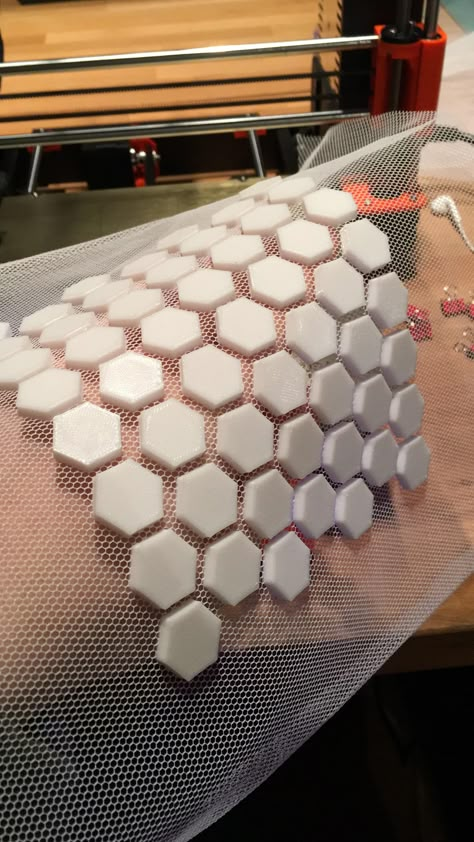 Indeed, the 3D printer must have a heating plate capable of reaching at least 230°C, an extrusion at 350°C and a closed chamber. Today, about 65% of these materials are printed with FDM technology, but they are also found in powder form, compatible with SLS technology. Learn more in our dedicated guides on PEEK and PEKK.
Indeed, the 3D printer must have a heating plate capable of reaching at least 230°C, an extrusion at 350°C and a closed chamber. Today, about 65% of these materials are printed with FDM technology, but they are also found in powder form, compatible with SLS technology. Learn more in our dedicated guides on PEEK and PEKK.
Image via VisionMiner
Polypropylene (PP)
Polypropylene is another thermoplastic widely used in the automotive sector, professional textiles sector, and in the manufacturing of hundreds of everyday objects. PP is known for its resistance to abrasion and its ability to absorb shocks, as well as relative rigidity and flexibility. However, drawbacks of the material include its low temperature resistance, and sensitivity to UV rays which can cause it to expand. Due to this, several manufacturers have developed alternative types of PP, simili-propilenos, that are stronger both physically and mechanically.
Nylon
Objects made from polyamides (nylon) are usually created from a fine, white, granular powder with SLS technology.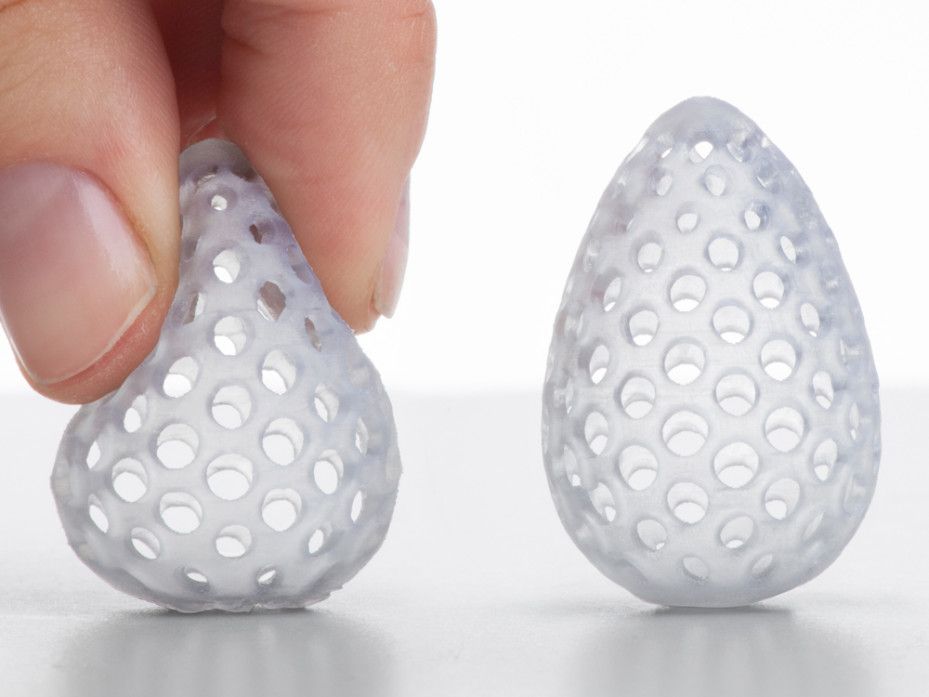 There are however some variants of the material such as nylon that are also available in filaments used in fused deposition modeling (FDM). Due to its biocompatibility, polyamides can be used to create parts that come into contact with food (except foods that contain alcohol).
There are however some variants of the material such as nylon that are also available in filaments used in fused deposition modeling (FDM). Due to its biocompatibility, polyamides can be used to create parts that come into contact with food (except foods that contain alcohol).
Constituted of semi crystalline structures, polyamides have a good balance of chemical and mechanical characteristics that offer good stability, rigidity, flexibility, and shock resistance. These advantages mean that the material has many applications across sectors and offers a high level of detail. Due to its high quality, polyamides are used in the manufacture of gears, parts for the aerospace market, automotive market, robotics, medical prostheses, and injection molds. You can learn more in our dedicated guide on Nylon.
Image via Sculpteo
Composites
Composites are extremely beneficial when making lightweight yet strong parts. The fibers add strength to a part without adding weight, which is why we also refer to composites as fiber reinforced materials. There are two types of reinforcements, short fiber or continuous fiber. In the first case, chopped fibers, which consist of segments less than a millimeter in length, are mixed into traditional 3D printing plastics to increase the stiffness and to a lesser extent the strength of components. Chopped fibers can be mixed with thermoplastics such as nylon, ABS or PLA.
There are two types of reinforcements, short fiber or continuous fiber. In the first case, chopped fibers, which consist of segments less than a millimeter in length, are mixed into traditional 3D printing plastics to increase the stiffness and to a lesser extent the strength of components. Chopped fibers can be mixed with thermoplastics such as nylon, ABS or PLA.
Alternatively, the fibers can be added to the thermoplastics continuously to arrive at a stronger part. The main fiber used in the 3D printing sector is carbon fiber, but there are also other fibers such as glass fiber or Kevlar. You can find more information in our dedicated guide.
Carbon fiber reinforced filament spool
Hybrid Materials
There are a variety of hybrid materials that mix base plastics with powders to give them a new color, finish or additional material properties. Often based on PLA, these materials are usually made of 70% PLA and 30% hybrid material. For example, wood-based filaments ranging from bamboo, cork, wood dust, and more are available. These wood-based materials mixed with PLA give the hybrid filament a more organic texture. Additionally, some hybrid materials incorporate metal powders to work with FDM-based technologies, to give parts a metal finish. They can be based on copper, bronze, silver, and more.
These wood-based materials mixed with PLA give the hybrid filament a more organic texture. Additionally, some hybrid materials incorporate metal powders to work with FDM-based technologies, to give parts a metal finish. They can be based on copper, bronze, silver, and more.
3D filaments based on wood.
Alumide
Alumide plastic objects are manufactured from a combination of polyamides and aluminium powder using the SLS process. The material has a large, slightly porous surface and a gritty, grainy appearance offering great strength and good temperature resistance (up to 172°C). However, some post-processing treatments are necessary, such as grinding, sanding, coating, or milling.
Alumide is used for complex models, design pieces, or for small series production of functional models that need high rigidity and an appearance similar to aluminium. This technique involves few geometric limits.
Soluble Materials
Soluble materials are materials printed with the intention of being dissolved in a future stage of the manufacturing process. The two most common soluble filament materials are HIPS (High Impact Polystyrene) and PVA (Polyvinyl Acetate). HIPS is associated with ABS, and can be dissolved with limonene, whereas PVA is associated with PLA and can be dissolved using just water.
The two most common soluble filament materials are HIPS (High Impact Polystyrene) and PVA (Polyvinyl Acetate). HIPS is associated with ABS, and can be dissolved with limonene, whereas PVA is associated with PLA and can be dissolved using just water.
There are also BVOH filaments which are becoming increasingly popular, especially in dual extruder printers. This is because the material is soluble in water, and according to experts has a higher solubility than PVA.
Flexible Materials
A newer type of filament, and one of the most successful, are flexible filaments. They are similar to PLA, but usually made out of TPE or TPU. The advantage of using these filaments for 3D printing is they allow for the creation of deformable objects, widely used in the fashion industry. Generally, these flexible filaments have the same printing characteristics as PLA, though they come in a variety of ranges based on their stiffness. It is worth finding out which type of extruder is best suited to the material to avoid jams when 3D printing.
Flexible materials are widely used in fashion and design
Resins (for photopolymerization-based 3D printing)
3D printing technologies based on photopolymerization use UV-sensitive resins to create objects layer by layer. In other words, they use a light source such as a laser or LCD screen to solidify a liquid photopolymer. Technologies include SLA, DLP, and even Material Jetting (PolyJet). Creating parts using resins results in high detail and smooth surface objects, nevertheless, the color range is still quite limited using this process. What differentiates resins from FDM filaments is that it is impossible to mix resins to obtain different results quite easily.
Standard resin has properties similar to ABS: the surface finish of the part will be good given the photopolymerization process, however mechanical properties will be moderate. More advanced resins do exist for technical applications such as in dentistry (also need to be biocompatible), or engineering.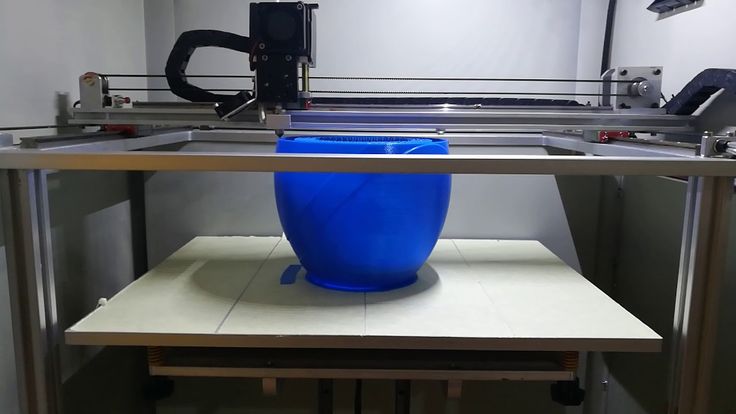 Additionally, flexible resins that offer greater flexibility and deformation can be used to make jewelry. Over the years, manufacturers have expanded their range of liquid photopolymers to answer manufacturing needs from various sectors. Therefore, you should be able to find resins that have high-temperature resistance, can withstand large impacts, or that have high elongation properties.
Additionally, flexible resins that offer greater flexibility and deformation can be used to make jewelry. Over the years, manufacturers have expanded their range of liquid photopolymers to answer manufacturing needs from various sectors. Therefore, you should be able to find resins that have high-temperature resistance, can withstand large impacts, or that have high elongation properties.
The 3D printing resin is poured in a tank
What do you think of our explanation of these 3D printing plastics? Let us know in a comment below or on our Facebook and Twitter pages! Don’t forget to sign up for our free weekly Newsletter, with all the latest news in 3D printing delivered straight to your inbox!
3D Printing with Polymers: All You Need to Know in 2021
A deep dive into polymer 3D printing: technologies, promising developments, applications, and more.
As major chemical companies are now joining the 3D printing world and industry mainstays are further advancing the capabilities of the technology, polymer 3D printing is given a tremendous boost.
To keep up to the latest developments, below we’ll be diving into the most exciting innovations in polymer 3D printing and opportunities offered by the technology. But first, let’s explore the common polymer 3D printing techniques used across industries.
Contents
Polymer 3D Printing: The Technologies
Polymer 3D printers dominate the 3D printing hardware arena. They lead on all fronts: shipment revenues, the installed base, and the number of developments happening in this space.
Polymer 3D printing was predicted to have generated $11.7 billion in revenues in 2020, a figure that includes sales of hardware, materials and 3D-printed parts combined.
Below, we’re taking a look at the key technologies driving this growth.
[Image credit: AMPOWER]Vat Polymerisation
Stereolithography
The emergence of Stereolithography (SLA) in the 1980s marked the beginning of the 3D printing era. SLA is an ideal technology for producing great looking parts with an excellent surface finish.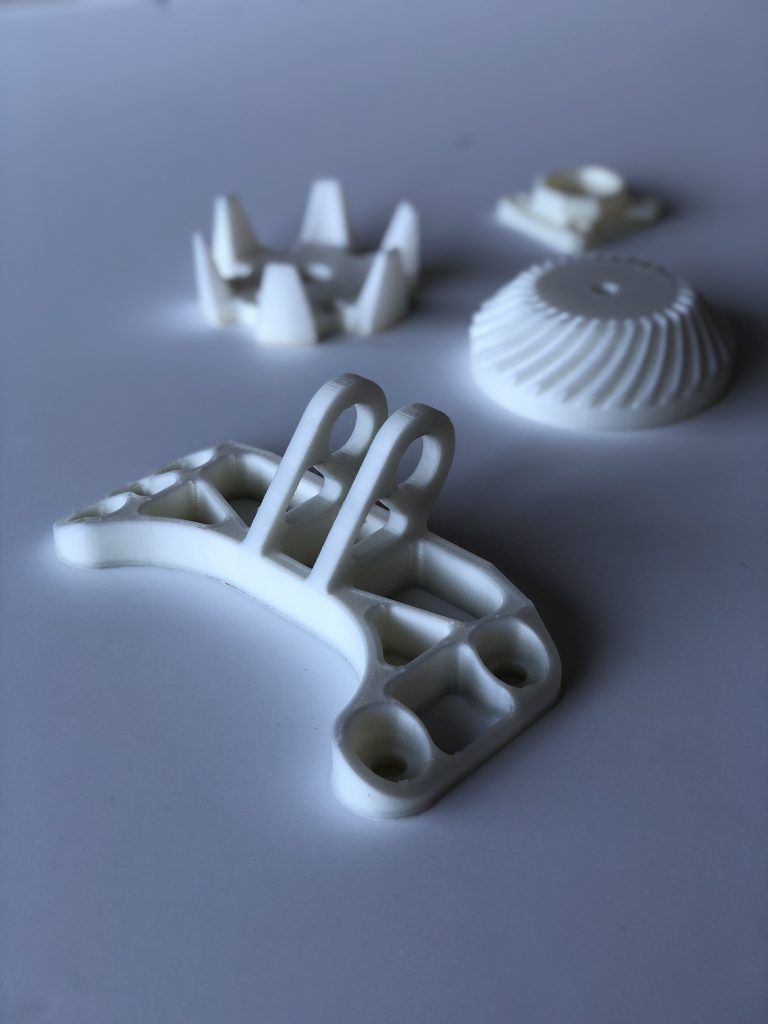 Due to its accuracy and high resolution, SLA parts are mostly used for form and fit concept models or as master patterns for moulding applications.
Due to its accuracy and high resolution, SLA parts are mostly used for form and fit concept models or as master patterns for moulding applications.
SLA relies on liquid photocurable resins. These are selectively cured by a UV laser layer by layer, causing the resin to solidify.
While SLA parts offer a great surface finish, they tend to be less durable than parts produced with other additive technologies. Also, since SLA materials are sensitive to UV light, their mechanical properties can change due to overexposure to sunlight, thus making them unsuitable for outdoor use.
SLA photopolymers come in a variety of colour options as well as several speciality materials (castable, durable, high-temperature, medical-grade).
The choice of materials for SLA is constantly expanding. Over the last 12 months, we’ve heard multiple announcements about new 3D printing resins from the likes of Formlabs, Henkel, Zortrax, DSM, and many more.
What can be distilled from the recent news is that 3D printing resin development has reached a new level: companies are extremely focused on advanced applications, particularly in the medical, dental and engineering fields.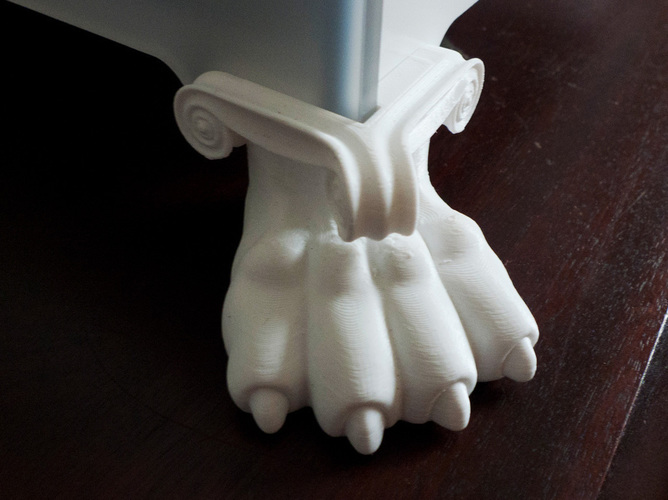
Read also: 3D Printing for Digital Dentistry & Clear Aligner Manufacturing
Material Extrusion
FDM/FFF
Fused Deposition Modeling (FDM), as known as fused filament fabrication (FFF), is one of the most popular 3D printing methods for industrial uses. According to a market research firm, CONTEXT, the largest revenues from shipments came from this category of machines in 2020, reaching almost $150 million.
FDM became commercially available in the 1990s, serving as an affordable and user-friendly prototyping technology. Since then, FDM has evolved to offer greater reliability, accuracy and material choice, making it suitable for a number of production applications such as manufacturing aids.
Read also: 3D Printing for Aircraft Cabins
FDM uses thermoplastic filaments that are extruded through a nozzle onto the printing platform one layer at a time. One of the main limitations of FDM parts is anisotropy, meaning that their mechanical properties are not equal in all spatial dimensions.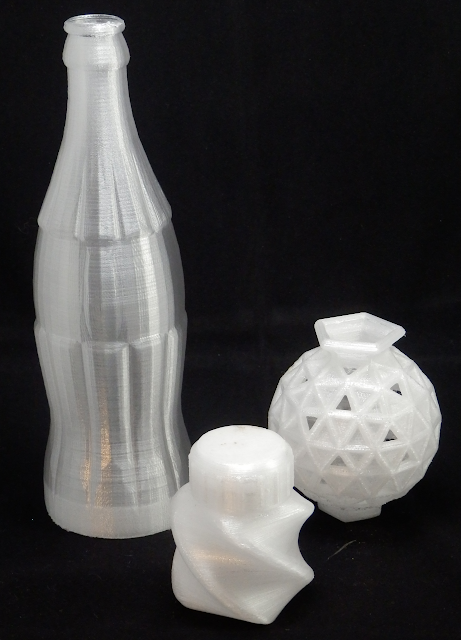 This can result in weaker parts.
This can result in weaker parts.
Furthermore, FDM has a slower printing speed compared to other 3D technologies like SLS or SLA, making it generally impractical for series production.
Today, manufacturers have a variety of FDM filaments at their disposal, from elastic TPU to durable and reinforced ABS and high-performance materials like PEEK. With the availability of production-grade thermoplastics, FDM is ideal for producing functional, durable products.
Powder Bed FusionSelective Laser Sintering
Selective Laser Sintering (SLS) is an additive manufacturing process that involves the fusing of plastic powdered material using a powerful laser. With a combination of high accuracy, speed, reliability and lack of support structures, SLS is used both for functional prototyping and low-volume production.
SLS typically uses polyamide (nylon) powders, with PA11 and PA12 being the two most commonly used polyamides, in addition to flexible TPU material.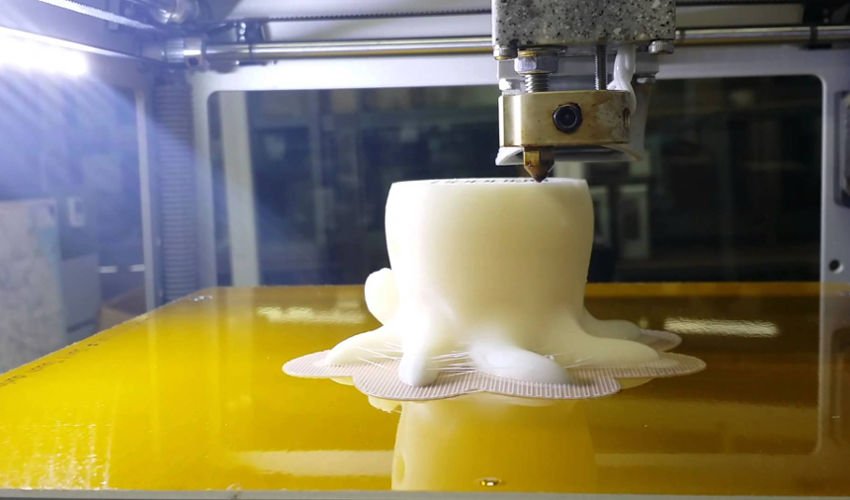
However, companies are continually adding new material offerings. For example, in 2018, Evonik released the world’s first flexible plastic PEBA-based (polyether block amide) powder for SLS.
German 3D printer manufacturer EOS has also made available carbon-fibre reinforced PEKK thermoplastic for its SLS systems, in addition to its certified PEEK material. The new PEKK thermoplastic is said to be able to replace aluminium parts in aerospace and industrial applications.
Notably, EOS is currently the only manufacturer that offers an SLS system capable of processing high-performance thermoplastics like PEEK and PEKK – the EOS P800.
Historically, SLS technology has been more expensive for companies to acquire (costing into the hundreds of thousands of dollars). However, in 2014, the patent for the technology expired, giving rise to more affordable alternatives, such as the Formlabs Fuse 1 benchtop 3D printer.
Multi Jet FusionSince its introduction to the market in 2016, HP’s Multi Jet Fusion (MJF) has opened a new dimension for the production of industrial-grade functional parts and prototypes.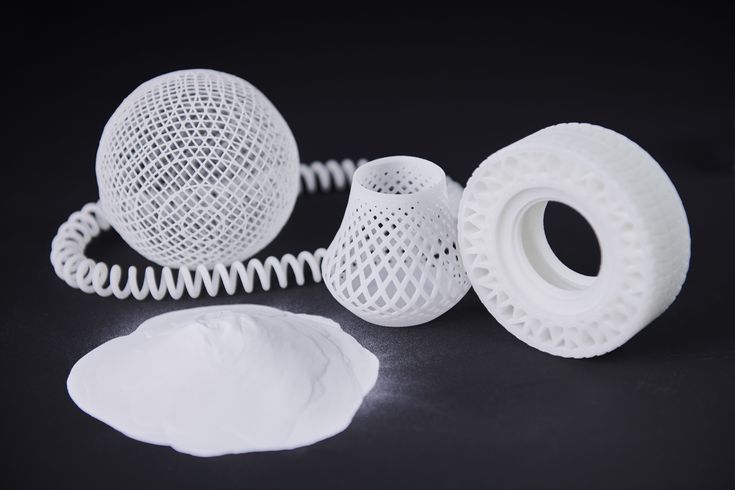
Like SLS, the technology uses nylon powders. However, instead of using lasers, MJF operates by dropping a fusing agent on each layer of powder, which is then fused by an infrared light source.
Compared to SLS, MJF offers a faster workflow due to HP’s innovative post-processing station, which speeds up the cooling process and aids in powder removal. The Jet Fusion 300/500 series also offers full-colour 3D printing capabilities.
There are a few limitations with HP’s Multi Jet Fusion, for example, its currently limited material selection (PA11, PA12, PA12 filled with glass beads).
However, HP promotes an Open Platform model, which encourages collaboration with material developers. Through this approach, HP has partnered with over 50 companies, including Evonik, BASF and Lubrizol, which are working on the development of new materials suitable for the technology.
Read also:
–The Evolution of HP’s 3D Printing Technology: From Polymer to Metal AM
–AMFG and HP compatibility drives AM system connectivity
Material JettingMaterial Jetting is an inkjet printing process that involves depositing a liquid photoreactive material onto a build platform layer by layer.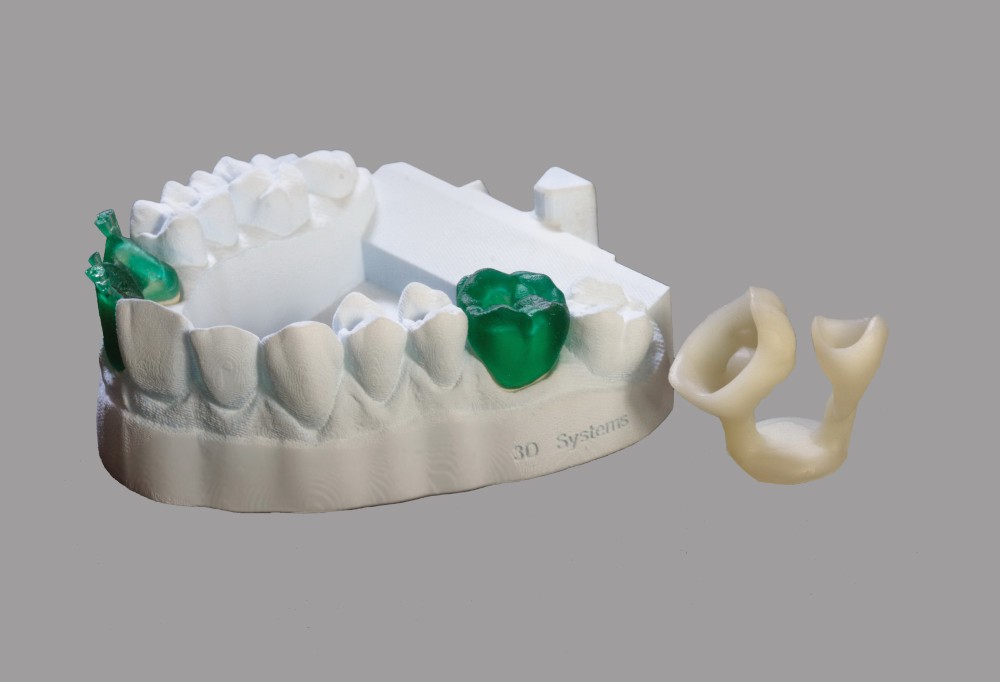 Similarly to SLA, Material Jetting uses resins, which solidify under a UV light.
Similarly to SLA, Material Jetting uses resins, which solidify under a UV light.
One of the key benefits of Material Jetting is the ability to combine two or more photopolymers during the printing process, resulting in a part with hybrid properties (e.g. combining rigidity with flexibility). Furthermore, the technology is capable of producing full-colour parts, which makes it ideal for prototypes with a final-product look.
Resins used in Material Jetting are similar to those used in SLA, but have a less viscous, ink-like form. Their cost is also typically higher.
Among the limitations of the technology is the poor mechanical properties of the printed parts, which make material jetted parts generally unsuitable for functional applications.
Polymer 3D Printing: The Opportunities and Applications
Industrial 3D printing with polymer materials unlocks a wide array of possibilities both for production and product development departments. Below, we’ve outlined the most prominent of them.
Below, we’ve outlined the most prominent of them.
Rapid prototyping
Prototyping remains one of the primary application areas for polymer 3D printing. With the evolution of 3D printing technologies, prototypes can now be produced much faster, they are more durable and visually appealing.
The automotive industry, which is said to have purchased the greatest number of printers in 2017, is a prominent user of polymer 3D printing for prototyping purposes. Here, all kinds of 3D printing technologies are leveraged both for form and fit, as well as functional, testing and validation.
One example is Audi, which is using Stratasys’ J750 PolyJet 3D printer to design and validate parts, such as taillight covers, for its automobiles.
As a full-colour, multi-material process, Stratasys Polyjet 3D printing allows building physical prototypes with the final product look, thus considerably simplifying and accelerating the product development process.
Tail light cover 3D-printed prototypes [Image credit: Audi]
In the motorsports sector, 3D printing is a go-to technology when it comes to producing functional parts for race car testing.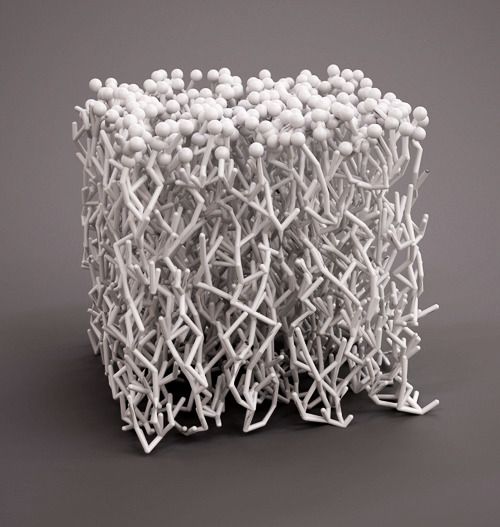 The Alfa Romeo Sauber F1 Team, for example, extensively uses SLS and SLA 3D printing to produce parts including front wings, brake ducts and suspension covers, as well as engine covers, internal ducts and hand deflectors for wind-tunnel car models.
The Alfa Romeo Sauber F1 Team, for example, extensively uses SLS and SLA 3D printing to produce parts including front wings, brake ducts and suspension covers, as well as engine covers, internal ducts and hand deflectors for wind-tunnel car models.
More efficient tooling
3D printing for tooling has emerged as one of the most promising uses of the technology. From jigs and fixtures to investment casting patterns, polymer 3D printing opens the door to faster, cheaper and customised tools.
Generally, companies turn to FDM and SLA technologies to produce tooling due to their relative affordability and ease of use.
Car manufacturer Ford is reported to be using Ultimaker FDM 3D printers to create custom tools.
The benefits go beyond affordability, too. According to Ford’s Technical Leader, Harold Sears, 3D printing is “helping people do their jobs by making tools that are more ergonomically correct for operators. This is perhaps a soft benefit but one that is certainly helpful if operators are happier and more comfortable doing their job.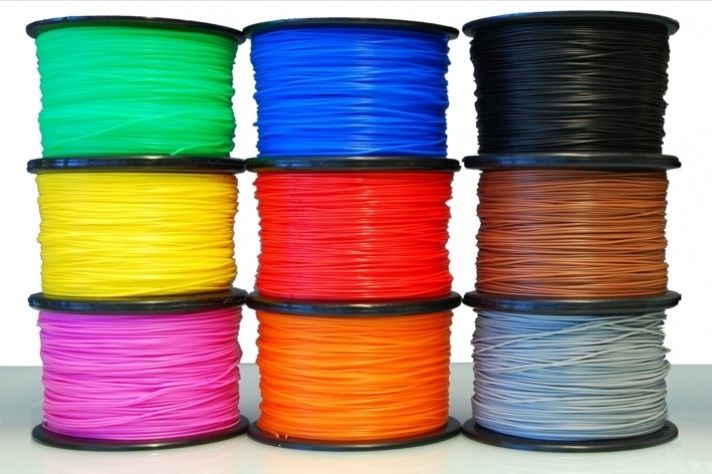 They’ll also do a better job which only improves quality.”
They’ll also do a better job which only improves quality.”
Additionally, at times the available 3D printable thermoplastic materials currently available are even strong enough to replace metal tools, which makes the assembly process a lot easier and lowers the cost of the custom tool.
Medical applications
The medical industry was one of the early adopters of polymer 3D printing. Today, the technology has found a number of uses in the sector, from 3D printed surgical guides and tools to replicas of human organs for pre-surgical planning.
Increasingly, 3D printing is being used to directly produce custom medical devices, including low-cost prosthetics and dental devices such as aliners and bridges.
One of the sectors of the industry that has been completely transformed by 3D printing is hearing aids. Today, more than 90% of hearing aids are manufactured worldwide using SLA 3D printing technology.
Since the outbreak of the pandemic, polymer 3D printing has also established itself as a viable technology for the production of ventilator valves, safety goggles, protective face shields and testing swabs.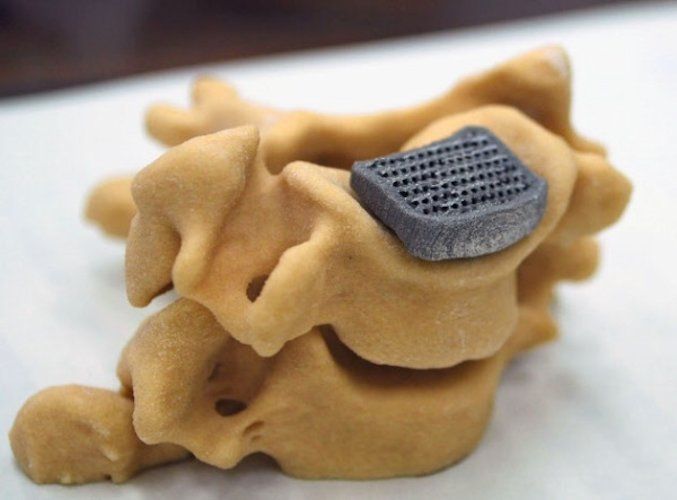
Read also: 3D Printing In Healthcare: Where Are We In 2021?
Customised consumer products
Consumer goods companies are increasingly eyeing plastic 3D printing as an option for mass customisation. Since 3D printing doesn’t require labour-intensive and costly tooling and can create complex objects cost-effectively, it enables the production of personalised products tailored to consumers.
One brand exploring 3D printing is Dr. Scholl‘s, the provider of foot care products. It has partnered with technology company Wiivv to make custom 3D printed inserts.
Using Wiivv Fit Technology, Dr Scholl’s offers a customisation app, which maps out 400 points on each user’s feet with a few phone photos. Though this process, which takes less than five minutes, inserts can be designed and then printed to the exact specifications of customers‘ feet.
Read also:
• 3D Printing for Footwear
• 5 Ways 3D Printing Can Benefit the Consumer Goods Industry
Exciting Technological Developments in Polymer 3D Printing
The 3D printing industry is making leaps in developing new polymer 3D printing technologies and improving existing ones. Below, we’ve outlined the recent most significant technological developments in the field of polymer 3D printing.
Below, we’ve outlined the recent most significant technological developments in the field of polymer 3D printing.
EOS’s new LaserProFusion technology
Announced at Formnext 2018, the LaserProFusion technology from EOS is an innovative polymer 3D printing technology being developed to enable serial additive production. The process relies on up to one million diode lasers that can reach up to 5kW power output to print plastic materials.
EOS’s LaserProFusion technology will be equipped with up toa million of diode lasers to enable faster SLS 3D printing [Image credit: EOS]
With this technology, the manufacturing process is said to be ten times faster, thus achieving the same level of productivity as injection moulding.
Although it’s unclear when the system becomes commercially available, the announcement is yet another indicator of the industrialisation of 3D printing technologies.
High-speed photopolymerisation
[Image credit: Carbon]
Photopolymerisation, which includes the SLA and DLP processes, has evolved significantly over the last several years.
This technology has been forging ahead as a mass manufacturing process and the recent introduction of high-speed photopolymerisation has only accelerated this trend.
Almost all major players in this field have introduced systems capable of printing functional resin parts close to injection moulding volumes.
In 2014, Carbon introduced its high-speed Digital Light Synthesis technology, which evolved into a M2 3D printer capable of printing at the speed of 20 cm/hour.
Read also: Carbon’s Co-Founder Philip DeSimone on Moving Towards High-Volume Production with 3D Printing
In 2016, 3D Systems unveiled its take on high-speed, automated SLA – the Figure 4 system. Recent data highlight Figure 4 Production part print speeds up to 65 mm/hour, and prototyping speeds of up to 100 mm/hour.
Other companies followed, with the likes of EnvisionTEC (acquired by Desktop Metal), Nexa3D, Origin (acquired by Stratasys) and NewPro.
Process speed in 3D printing has long been one of its weakest sides.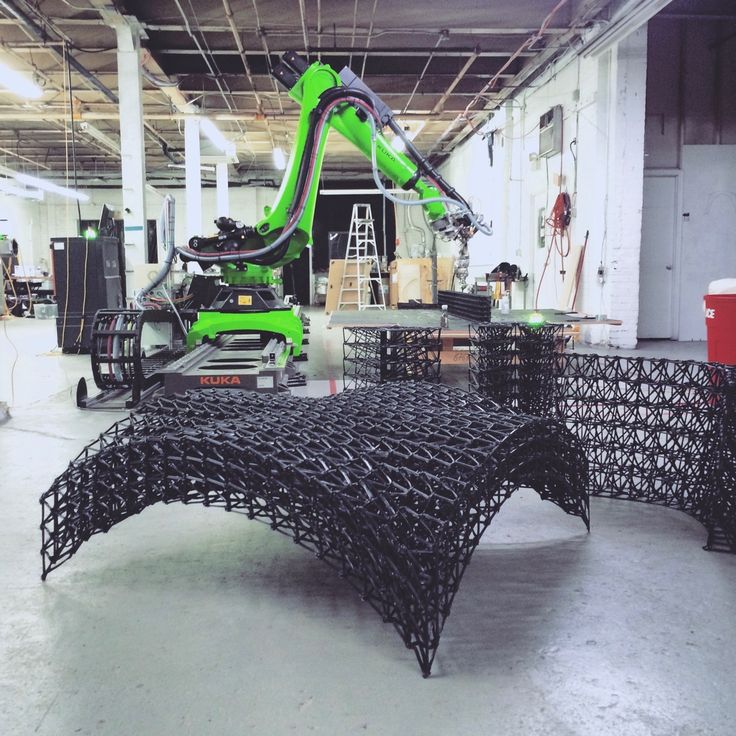 This, particularly, is an obstacle for adoption in industries driven by mass serial production, such as automotive and consumer goods. In these industries, products need to be manufactured and delivered in as short a timeframe as possible, in order to maintain production efficiency.
This, particularly, is an obstacle for adoption in industries driven by mass serial production, such as automotive and consumer goods. In these industries, products need to be manufactured and delivered in as short a timeframe as possible, in order to maintain production efficiency.
Now, with the advancements in high-speed polymerisation, there is a viable option for manufacturers wanting to 3D print parts at higher volumes.
Rize’s Augmented Polymer Deposition (APD) technology
Eliminating post-processing has been a long-held dream in the 3D printing industry – and Rize’s technology promises to remove the post-processing pain points. The US-based 3D printer manufacturer has developed its hybrid Augmented Polymer Deposition (APD) technology, which combines material extrusion with ink-jetting.
This combination enables the printing of support structures that can be easily removed by hand once the printing process is finished, and without the need for any further post-processing operations.
APD technology has been used to make isotropic, full-colour, industrial-strength parts for prototyping, tooling and production applications.
Last year, the company also introduced a new feature, whereby users can 3D print secure information, like a QR or barcode, on a part with the help of the technology. This would allow, for example, an engineer to digitally store all of the information for a specific part, maintaining a digital inventory.
BigRep’s large-scale FDM 3D printing
One of the major barriers to the wider adoption of FDM for industrial applications is the size of the build envelope. This is a barrier the German company BigRep is repeatedly attempting to overcome with its incredibly large and highly capable line of 3D printers.
At formnext 2018, BigRep unveiled two next-generation 3D printers – the BigRep PRO (1005 x 1005 x 1005 mm) and BigRep EDGE ( 1500 x 800 x 600 mm) — geared towards industrial use.
Both systems are equipped with proprietary Metering Extruder Technology (MXT), which sets them apart from other large-scale options. This new extruder technology provides a clear separation between filament feeding, melting and extrusion, thus enabling faster printing speeds with greater precision and quality. For example, the BigRep PRO is said to offer five times the filament throughput rate and three times the average extrusion rate, compared to other FDM machines available on the market.
This new extruder technology provides a clear separation between filament feeding, melting and extrusion, thus enabling faster printing speeds with greater precision and quality. For example, the BigRep PRO is said to offer five times the filament throughput rate and three times the average extrusion rate, compared to other FDM machines available on the market.
The MXT is optimised to work with professional-grade materials like ASA/ABS and nylon that BigRep is producing in collaboration with the German chemical company BASF.
Notably, the BigRep PRO incorporates state-of-art CNC control systems and drives by Bosch Rexroth, enabling IoT and data processing capabilities. This will ultimately help accelerate the printer’s integration into the Industry 4.0 vision.
More on this: 4 Impressive Applications of Large-Scale 3D Printing
Evolve’s STEP technology
More and more 3D printer manufacturers are setting their eyes on mass production, and Stratasys spin-off Evolve Additive Solutions is no different.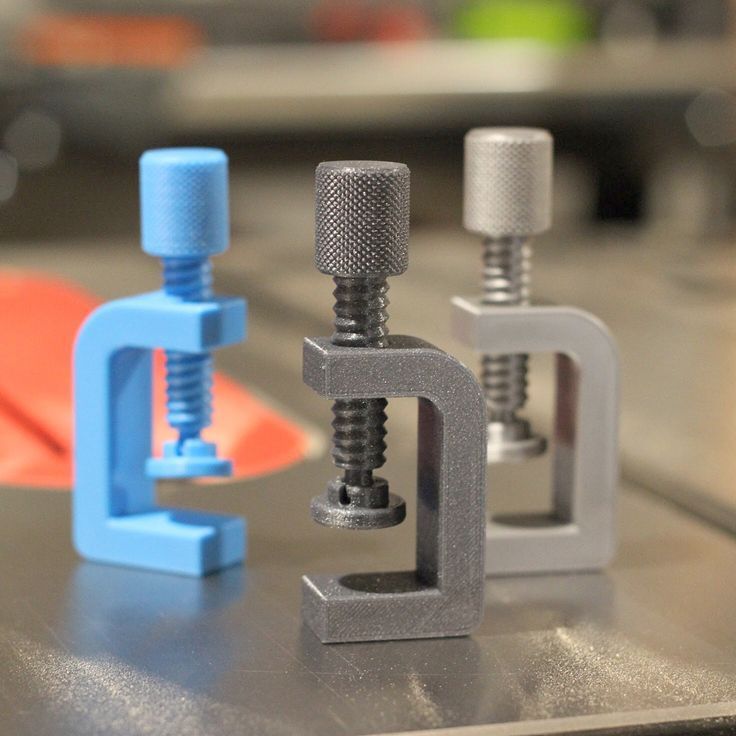
After almost a decade of development, the company unveiled its new production-speed “STEP” (short for Selective Toner Electrophotographic Process) technology for polymers last year.
Evolve’s STEP process offers a novel approach to volume production with additive manufacturing, not least because it is said to be 50 times faster than the fastest 3D printing technologies available.
What’s more, the company claims that the technology is capable of producing parts with quality comparable to those made with conventional methods, and not just in terms of aesthetic finish, but also strength. Additionally, STEP technology provides multi-material and full-colour printing capabilities.
Although Evolve is still two years away from commercialisation, their technology will be one to keep an eye on.
Stratasys’ SAF
The 3D printing industry mainstay, Stratasys, also continues to increase its presence in the rapidly expanding area of production-grade 3D printing systems. The company just presented the upcoming line of powder bed fusion (PBF) based 3D printers.
The company just presented the upcoming line of powder bed fusion (PBF) based 3D printers.
The new H Series Production Platform will be powered by Selective Absorption Fusion (SAF) technology specifically designed to meet the needs of volume manufacturing.
SAF is a powder-based 3D printing process. However, while SLS uses a laser to selectively fuse polymer particles, SAF does something entirely different.
SAF uses a counter-rotating roller to coat powder layers onto a print bed and then printheads selectively drop absorber fluid to form the part’s layer. The imaged layer is fused by passing an IR lamp over the entire span of the print bed, causing the selected regions to fuse.
What’s good about this new process is that it will reportedly offer high printing speed and scalability. Commercial availability of 3D printers based on SAF technology is currently expected in the third quarter of 2021.
If Stratasys’ SAF delivers on its vision, it could become a viable alternative to the established SLS and Multi Jet Fusion processes.
Polymer 3D printing market consolidation
The additive manufacturing industry has seen a spate of acquisitions and mergers over the last six months, many of which were in the polymer AM sector.
While M&A activity is nothing new in the AM space, recent announcements have something significant in common: production focus.
Here are some highlights of the recent M&A moves in polymer 3D printing:
- In September 2020, Covestro announced the intent to acquire the DSM Resins & Functional Materials line of business, including DSM Additive Manufacturing.
- In December 2020, Stratasys announced the acquisition of Origin.
- In January 2021, Desktop Metal announced the intent to acquire EnvisionTEC.
It’s encouraging to see companies coming together to strengthen their offerings and present compelling solutions for industrial AM production.
This desire to expand process and materials portfolios to include more options from a single parent source operating through a single distribution network will enable a lot more customer requests to be met.
Doing so on a large scale, with a focus on repeatability and reliability, is a major step forward for polymer 3D printing.
Using plastic instead of metal
Weight reduction is a particular goal for some industries like aerospace and motorsports. Making an aircraft or a vehicle lighter helps reduce fuel consumption and optimise a vehicle’s performance.
While these industries generally rely on metal lightweighting solutions to reduce weight, the recent advancements in polymer 3D printing materials offer some exciting opportunities. The ability to 3D print high-performance thermoplastics like carbon-fibre, ULTEM and PEEK can mean metals can be replaced with plastics in some applications.
According to one analysis, replacing aluminium aircraft brackets with PEEK alternatives can result in a 5% to 9% weight reduction, which can have a tremendous bottom-line impact on the fuel consumption of an aircraft.
Replacing a metal part with 3D-printed plastic can also be beneficial for speeding up the maintenance process. One service bureau has used Stratasys FDM Nylon 12CF carbon-filled thermoplastic to make a replacement for a metal machine part. 3D printing the spare part resulted in a superior component, produced much faster than its conventionally manufactured counterpart.
Read also: Composite 3D Printing: An Emerging Technology with a Bright Future
Things to consider when adopting polymer 3D printing in-house
Sustainability
Recycling and reuse of polymer 3D printing materials is an important factor to consider when adopting polymer AM in-house.
In filament-based 3D printing, recycling is commonplace, with many companies producing plastic filaments from recycled plastic.
However, while thermoplastics, like filament, can be easy to recycle by just remelting them, thermoset plastics cannot be remelted, which means they are unable to be recycled.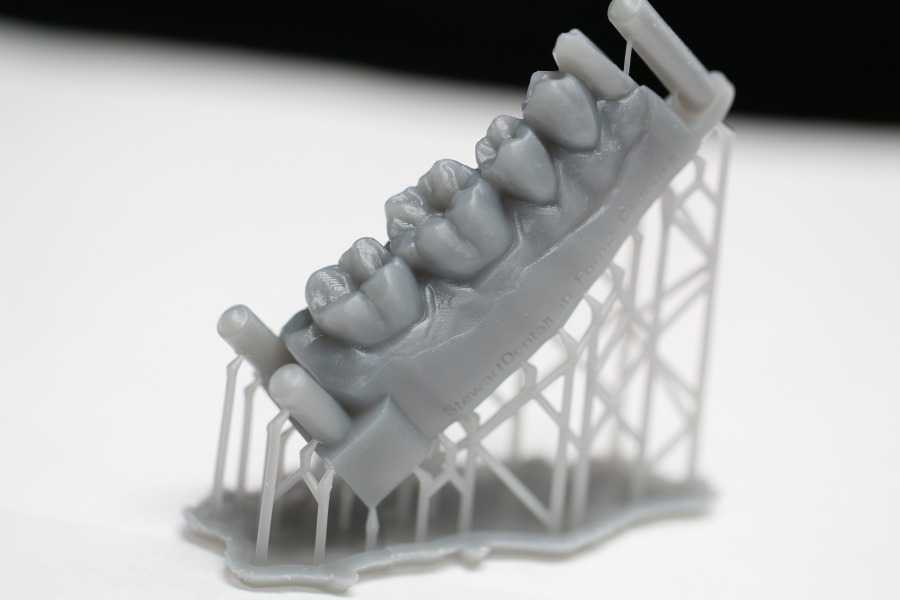
In powder-based polymer 3D printing, powder reuse is also not entirely straightforward. In most cases, you’ll need to mix ‘used-but-unfused’ powder with about 50% virgin powder, in order for it to be reused. For some high-performance powders like PEEK, the refresh rate is drastically reduced and, in some cases, none of the excess powder can be reused.
So how can you print sustainably with polymer 3D printing materials? One way is by minimising waste through better designs. Additionally, make sure to contact your local waste or recycling centre to see if they have the capacity to dispose of 3D-printed polymers safely.
More on this: How Sustainable is Industrial 3D Printing?
Post-processing
Removal processes, such as support removal, resin or powder removal, are the most commonly employed post-processing operations in polymer 3D printing. They are typically performed manually, which takes up a lot of time and labour resources.
Further complicating this stage is the fact that you may want to use several 3D printing technologies, each with its own post-processing requirements.
To improve post-processing operations, companies, like Rösler, PostProcess Technologies, AMT and DyeMansion, have been developing solutions to help AM users streamline post-processing.
Currently, the biggest trend is on creating end-to-end post-processing solutions, covering sorting, material removal and de-powdering, smoothing and dyeing, and inspection.
When adopting polymer 3D printing, understanding the post-processing requirements is imperative. Unoptimised post-processing can add a lot of cost to 3D printing operations, which can and should be avoided through automation.
Workflow management
Adopting polymer 3D printing in-house will also require you to consider approaches to managing operations, such as order management, cost calculation, production scheduling, inventory management, etc.
Many companies today either rely on solutions initially developed for traditional manufacturing or develop their software internally. Each approach often leads to siloed workflow, which lacks visibility and can’t be easily scaled.
Not to fall into the trap of an inefficient, unscalable workflow, a good practice is to implement workflow management and manufacturing execution solutions that have been developed with 3D printing requirements in mind.
Several options are available on the market today but only a few offer end-to-end solutions that cover the entire 3D printing workflow.
To learn more about such solutions, discover our whitepaper “Additive Manufacturing MES Software: The Essential Guide”
The future of polymer 3D printing
From realistic concept models to sturdy prototypes, ergonomic tools and functional end-use parts, the opportunities created by polymer 3D printing are immense.
Although some challenges remain to be overcome, such as expanding the material selection and ensuring the reduction of material costs, ongoing developments in polymer 3D printing will help companies further reap the benefits of the technology.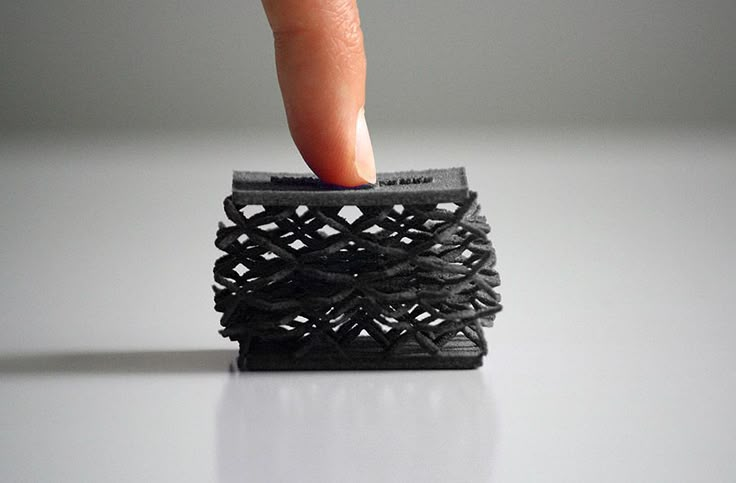
As the AM industry as a whole, and polymer 3D printing in particular, moves toward the production of end parts, we see 3D printable composites and high-performance thermoplastics gaining greater traction.
While polymer 3D printing won’t replace conventional processes, the technology will certainly enhance current manufacturing capabilities, further unlocking advanced industrial applications.
Looking for more insight on polymer 3D printing? Check out the articles below:
Stereolithography & Digital Light Processing: Where Are We Today?
FDM 3D Printing: Where Are We Today?
The Evolution of SLS: New Technologies, Materials and Applications
3D printing with thermoplastic polymers: 12 domestic projects
Implementation stories
Rapid prototyping
Experts recommend
Author: Semyon Popadyuk
Author: Semyon Popadyuk
Thermoplastics and composites - what is it? | How are composites made? | Who are the main consumers of 3D printing resins? | What plastics are the most popular? | How is 3D printing with thermoplastics and composites applied? Examples of finished products
We are often asked the question: do they make high-quality, reliable and safe materials for 3D printing in Russia? Of course, there are such manufacturers, moreover, significant experience and know-how have been accumulated in this area.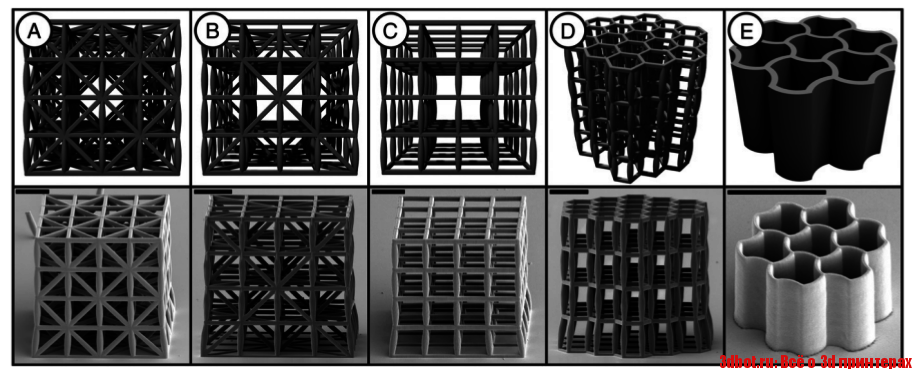 One of the pioneers in the domestic market for the production of plastics for the additive industry was REC. It is directly involved in the production of filaments, and its 3D Solutions division conducts R&D on the creation of composite materials.
One of the pioneers in the domestic market for the production of plastics for the additive industry was REC. It is directly involved in the production of filaments, and its 3D Solutions division conducts R&D on the creation of composite materials.
REC and 3D Solutions in facts and figures:
-
8 years of work with thermoplastics in the field of additive technologies;
-
22 different types of FFF filament material are mass-produced;
-
in 2020 and 2021, more than 130 different compositions based on thermoplastics were produced and tested;
-
own production equipment and laboratory complexes for the production and testing of thermoplastic compositions both in molding and in 3D printing;
-
the most recognizable brand in the field of FDM printing materials.
Dmitry Miller © youtube.com / JsonTV
Today, in our blog, REC and 3D Solutions Executive Director Dmitry Miller shares his experience in the development and application of thermoplastics and composite materials and talks about the most interesting FDM technology implementation projects.
Check if a 3D printer will solve your problems - order a free test 3D printing service from iQB Technologies!
Thermoplastics and composites - what is it?
A thermoplastic is a polymer that can become plastic when subjected to temperature. Based on thermoplastics, composites are produced - pure plastics in combination with other materials, for example, ABS with polycarbonate or reinforced with carbon fiber. There can be a huge number of such variations.
For eight years on the market, we have managed to work with most of the existing plastics, including ABS, ASA, SBS, SEBS, PA, PP, PSU, PPSU, PEEK, PC, TPU, TPEE, PET, PETG, PEI, PLA, PS, PTFE, PVA, PMMA, PBT. And this is not a complete list - some materials, such as PVC, could not be brought to an adequately usable state, because there are all sorts of difficulties with processing.
How are composites made?
We take the necessary polymer base and, depending on the task and the required properties of the material, we modify it with certain components. These include:
These include:
A wide range of fillers with different properties is also used. These are the most familiar carbon fibers, and fiberglass, and basalt fiber, and Kevlar fibers. To obtain certain properties, it is possible to fill the polymer with hollow glass spheres and carbon nanotubes.
We also have metal-filled polymers used in MIM (Metal Injection Molding) molding technology. It is more correct to call them metal-polymer compositions, since they contain more than 93% metal and at least 7% binder. A product is molded from such a composite material using casting or 3D printing, then the binder is chemically etched, the resulting model is baked in an oven, and finally we get an all-metal part.
In addition, compositions exhibiting ferromagnetic properties can be obtained. They are in demand in tasks related to radiography and radio electronics.
iQB Technologies experts recommend the article: Additive Manufacturing of Molding Tooling from Polymer and Composite Materials
Who are the main consumers of 3D printing resins?
Our main consumer is production, since additive methods create either the final product, or some part of it, or tooling for its production.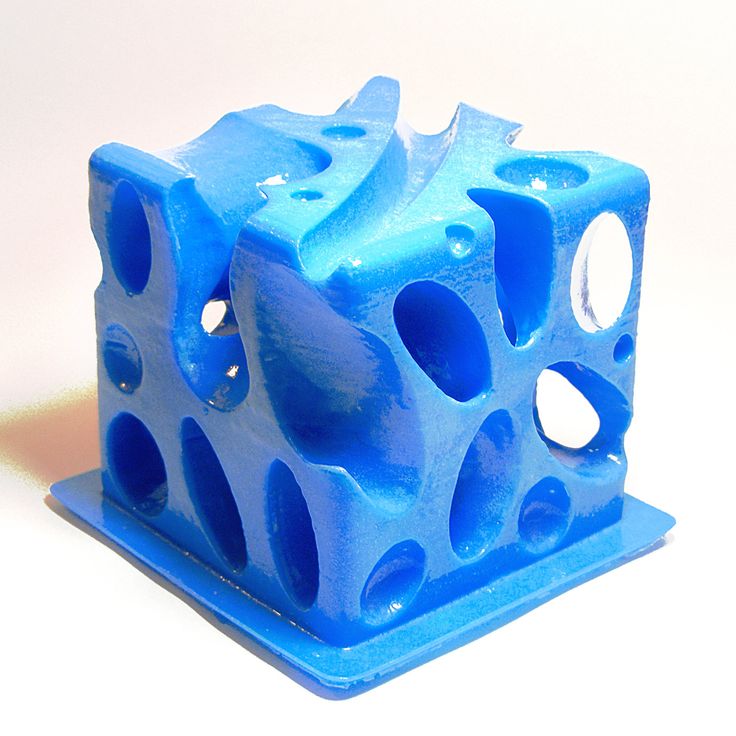 A large number of orders is due to the regularity, systematic repetition and stability of the production process.
A large number of orders is due to the regularity, systematic repetition and stability of the production process.
Slightly more than a quarter of the volume of production is engineering companies that are engaged in 3D printing of prototypes for assembly testing, visual models and the like.
A large layer, accounting for 25%, is the sphere of education. Thanks to federal programs such as "Point of Growth", 3D printers are supplied to many educational institutions, and additive technologies are an educational subject. Teaching the basics of 3D printing makes a huge difference as it helps students change the way they think. When we use classical subtractive technologies - turning a blank or cutting it with a laser, cutting something out of a flat sheet - this is one way of thinking. Additive manufacturing removes many restrictions, thinking is completely different, and the next generation will think in technical terms much more freely.
The next segment is occupied by personal consumption, which can affect absolutely any area.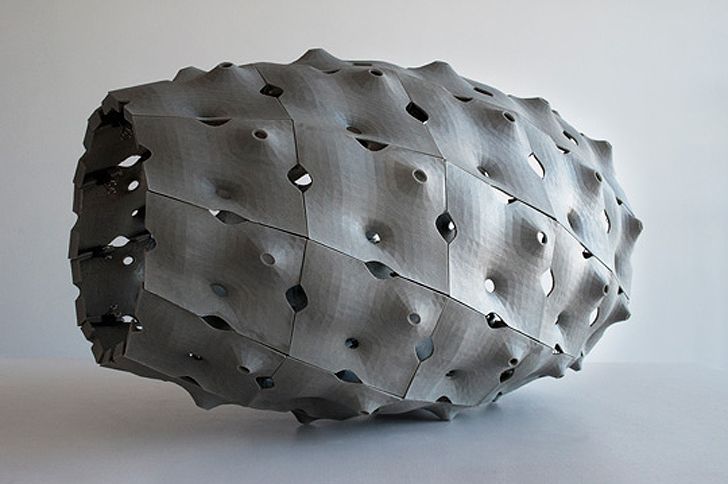 These are people, as well as small businesses, using 3D printers for their own purposes, hobbies.
These are people, as well as small businesses, using 3D printers for their own purposes, hobbies.
And finally, medicine. So far, the amount of work we have in this area is small, but there are precedents for application. Polymers are used for the additive production of orthoses (devices for fixing limbs), prosthetics, and, together with educational institutions, for the manufacture of anatomical models for various medical needs.
What plastics are the most popular?
For clients of REC and 3D Solutions, PLA occupies the first place in terms of consumption. This is well deserved, as it is easier to print than any other plastic, and it is the least demanding on equipment. Any simplest personal 3D printer will work fine with this material, and there will be no difficulties.
The second place is approximately equally divided by ABS and PETG materials. They are used in functional prototyping, where PLA is far from always applicable due to its extremely low heat resistance: at 50 degrees it is already soft.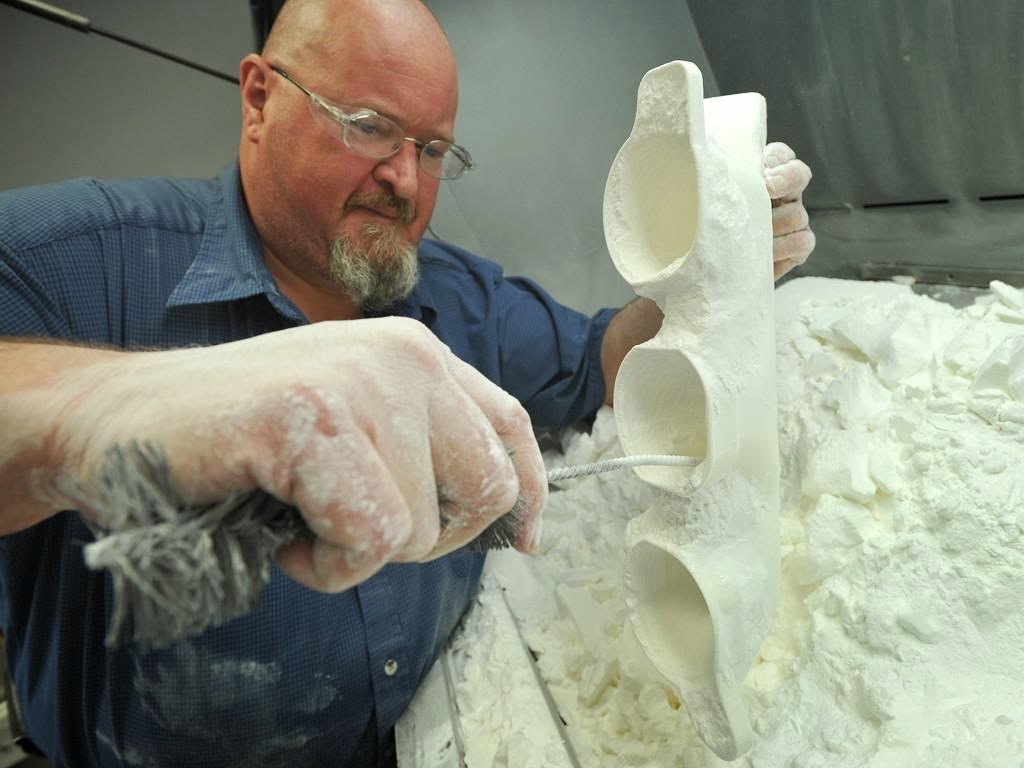
Next come various composite materials, and this segment is growing from year to year. In the next five years, they are likely to come out on top due to the ability to achieve any desired properties.
And a very small segment (4%) is made up of polyurethanes, ester elastomers - any flexible and elastic polymers. They are used by customers of all other materials, but for certain tasks that require elasticity and flexibility.
How is 3D printing with thermoplastics and composites applied? Examples of finished products
1. The prototype of an unmanned taxi and its components printed using FDM technology
Before you (Fig. 1) is a functional prototype of an unmanned taxi, containing a huge number of details. To make each of them by classical factory methods is quite difficult, expensive and time consuming. Thanks to 3D printing, the manufacturing company has optimized the process of creating many parts - reflectors for front optics, brackets, holders, decorative elements, etc. Models drawn on a computer were immediately printed and installed on the spot - so, as quickly and simply as possible, project of a fully functional working prototype vehicle.
Models drawn on a computer were immediately printed and installed on the spot - so, as quickly and simply as possible, project of a fully functional working prototype vehicle.
2. Grip for the robotic arm
An interesting example is when materials are combined for 3D printing. In the photo above, you can see the grip for the arm of the robotic arm. The claws themselves are printed from hard PETG plastic, while the inner pads are made from elastic material. It ensures that objects will not slip out of the manipulator's hand.
3. Model of the fuel system of the Angara rocket. Printed from ABS plastic, used to test the assembly of a complex device
Let's move on to complex systems. Figure 3 shows a real layout of the Angara space rocket power supply system, printed from ABS plastic, on which the assembly was checked. It was necessary to test whether the developed device with a large number of components can be assembled without damage.
4. Elements of LED lamps (medium runs)
Elements of LED lamps (medium runs)
And here you see how it is possible to produce complete end products using 3D printing. The company is engaged in the manufacture of LED lamps in small series. Some models have plastic elements - plugs, light diffusers. All products are designer, original, it turns out to be more expensive to make a thousand pieces by casting into silicone, not to mention the classic casting of molds: in such a run, the mold will not pay off at all, the parts will turn out to be “golden”. In this case, 3D printing is an extremely profitable solution. Unlike casting in silicone, additive manufacturing allows more freedom in geometry and a batch can be produced very cheaply and quickly.
The production speed is determined by the capacity of the 3D printer farm. As a rule, when we integrate 3D printing into production, we do not limit ourselves to one machine and create a farm. This is a whole fleet of identical additive installations to which the job is sent, and they immediately start printing together. In this way, we can significantly increase productivity. It is easily scalable and quite cheap, especially if FDM is used - the most affordable of all 3D printing technologies.
In this way, we can significantly increase productivity. It is easily scalable and quite cheap, especially if FDM is used - the most affordable of all 3D printing technologies.
5. Pots for levitating plants (small runs)
A curious startup project that specializes in levitating plants (Fig. 5). A tree in a pot flies over a wooden block, a magnet device works. So, the task was to make a planter. It should be light, not clay, so that it is easier to make a magnet, and not be afraid of such environment as earth, fertilizers and water. At first, there were attempts to produce wooden pots, but the wood, even with protective coatings, eventually deteriorated from the internal environment. Therefore, it was decided to introduce 3D printing with plastics. The company ordered 3D printing from us, but when it became clear that the production was profitable, it purchased equipment and materials and began to produce pots of various designs on its own.
6. Model of the foot, made according to CT
Medicine cannot be overlooked.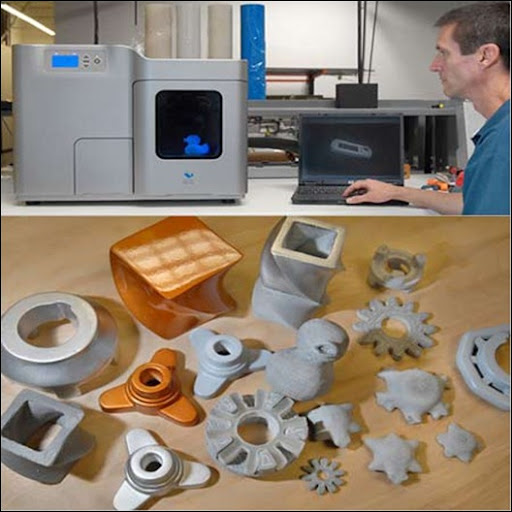 The photo shows a model of the foot printed from white plastic based on the results of computed tomography. The 3D model was obtained from CT and sent to the 3D printer. The product has two uses:
The photo shows a model of the foot printed from white plastic based on the results of computed tomography. The 3D model was obtained from CT and sent to the 3D printer. The product has two uses:
-
students with the help of such realistic models can practice, identify pathologies, since the use of real bones is very limited;
-
using this model, it is much easier for surgeons to plan an operation strategy and make it more accurate on the patient.
7. Prototype of endoprosthesis
Another medical device is a prototype endoprosthesis (Fig. 7). This is a preliminary model made of plastic, which is used to check the accuracy and correctness of the prosthesis. The final product is also created on a 3D printer, but already from metal, using SLM technology, obtaining a high-precision model of an individual endoprosthesis on the first attempt. Medical metal has a high cost and, in order to eliminate errors, prostheses are initially printed from plastic.
Read on: Plastic works wonders: how a 3D printer imitates human organs
8. Figures in the Olympic Museum in Sochi, printed on a 3D printer
Now let's see what benefits you can get using large format resin 3D printing. One of the most common areas of application today is the production of small architectural forms: sculptures, statues, decorative elements, architectural decorations (Fig. 8). Using a 3D printer, such models are created easily and quickly, and this is one of the cheapest ways to manufacture. In addition, there is the possibility of a wide choice of materials, adding optical effects, translucency (for example, to build a luminous element inside the sculpture for a greater effect).
9. An example of the texture of a printed product of large dimensions
As you know, FDM printing has one feature: due to the layered construction, the parts are “striped”. However, this disadvantage can be turned into an advantage and interesting textures can be created using a large-format 3D printer, as in Fig.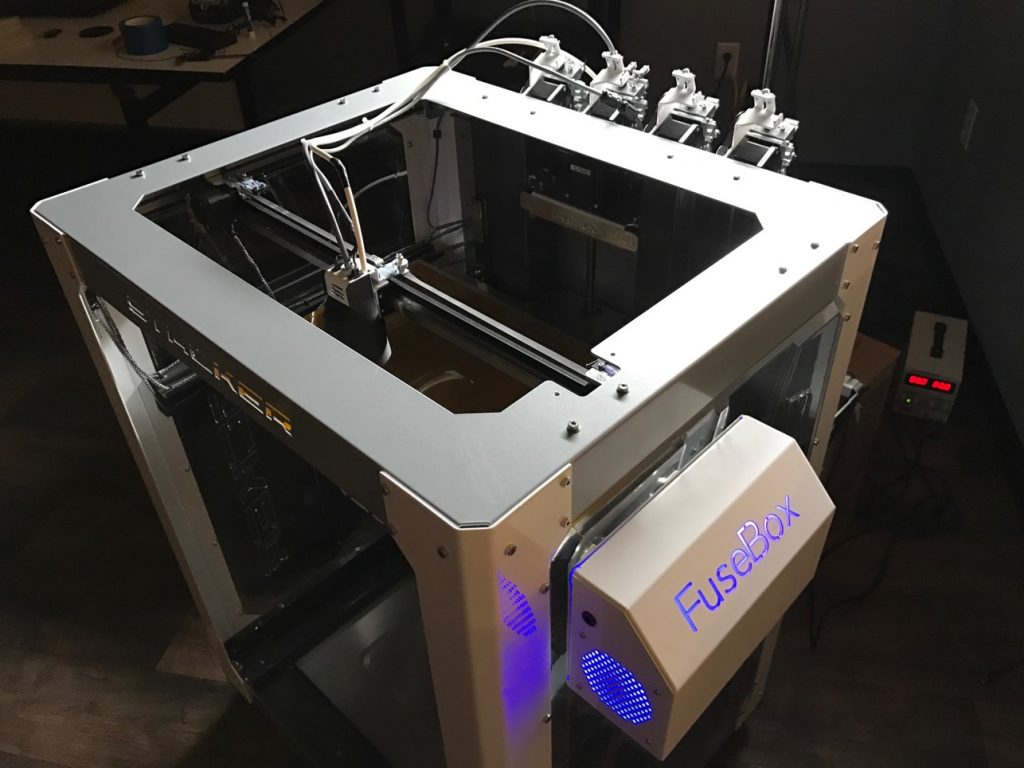 9. Of course, first of all, this is the production of designer furniture and various decorative elements and architectural forms.
9. Of course, first of all, this is the production of designer furniture and various decorative elements and architectural forms.
10. 3D printing with foam composite
For 3D printing of large objects using FGF technology using polymer granules, there is a separate layer of composite materials. On fig. 10 shows the process of printing with a material resembling polyurethane foam. The similarity is not accidental - a foaming composite is used here. One cubic meter of raw material yields 25 cubic meters of foamed material. And, as you can see, this technology allows you to achieve very large layer heights, and the thicker the layer, the faster the 3D printing. And a slight decrease in density facilitates the entire structure as a whole.
Learn more about large-format 3D plastic printing: solutions, challenges, case studies
FDM/FGF printing has a very low accuracy. Moreover, materials have different shrinkage, and in the case of different geometry of parts, shrinkage will be non-linear, unequal simply because of the peculiarities of the technology itself - because of how the material is laid, what temperature loads are applied.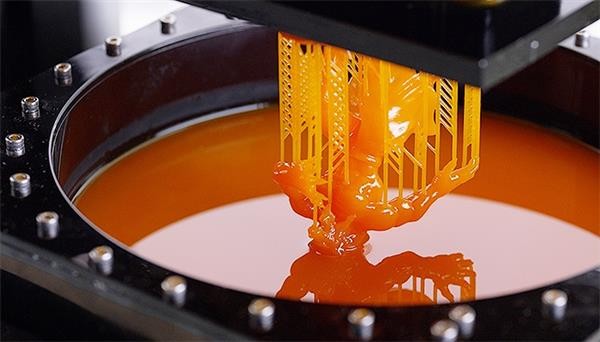 In the case of tooling production, as a rule, hybrid technologies are used - the model is printed, and then the working surface is milled. In this way, we obtain the desired roughness and precision.
In the case of tooling production, as a rule, hybrid technologies are used - the model is printed, and then the working surface is milled. In this way, we obtain the desired roughness and precision.
Different equipment requires different materials. Somewhere high heat resistance is needed, somewhere high strength, and somewhere the lowest possible price is a priority. There is an optimal material for each task.
And there is a huge field for optimizing production in order to produce large enough objects cheaply and in an incredibly short time - literally in a matter of hours.
Screensaver photo © zbulvar.ru
Article published on 11/12/2021, updated on 09/20/2022
3D printing laboratory - All about plastics - education, technology, perspectives
Prototyping and modeling using 3D printers has recently become more and more widespread. This is due not only to the development and cheapening of equipment for creating three-dimensional models, the emergence of new polymeric materials for three-dimensional printing, but also the emergence of the need for such modeling for medical products, aircraft parts, instrumentation, automotive and aircraft manufacturing, as well as souvenirs. and other areas. The use of polymeric materials for structural purposes for prototyping made it possible to produce not only models, but also small batches of technical products.
and other areas. The use of polymeric materials for structural purposes for prototyping made it possible to produce not only models, but also small batches of technical products.
According to the recent study “3D Printing Market (2013-2020)” published by Markets and Markets (“M&M”), between 2013 and 2020, the annual growth of the 3D printing market will be 23%, resulting in will grow to 8.4 billion US dollars by 2020 (http://www.orgprint.com/wiki/3d-pechat/obzor-tehnologij-3D-pechati).
3D printing is a technology for creating three-dimensional objects from a digital sample (CAD) by layer-by-layer application of additive materials. 3D printing methods include stereolithography (SLA), powder laser sintering (SLS), electron beam melting (EBM), layer-by-layer printing with molten polymer thread (FDM), formation of three-dimensional models from layer-by-layer sheet material (LOM) and others.
Initially, 3D printing was used exclusively for prototyping objects, but recently a radical step has been taken towards production.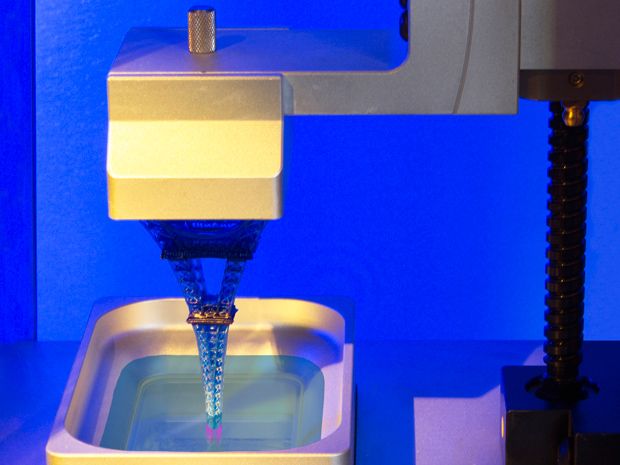 Automotive, aerospace, medical, and consumer products are among the industries that are actively embracing 3D printing. According to M&M, 3D printing in medicine and aerospace will grow exponentially in the near future. 3D printing has significant growth potential, it is indispensable where piece production of personalized products is needed.
Automotive, aerospace, medical, and consumer products are among the industries that are actively embracing 3D printing. According to M&M, 3D printing in medicine and aerospace will grow exponentially in the near future. 3D printing has significant growth potential, it is indispensable where piece production of personalized products is needed.
This article touches upon some aspects of 3D printing, which is carried out by layer-by-layer printing with a melted polymer thread (rod).
Layer-by-layer printing with molten polymer thread - it is also Fused Deposition Modeling or simply FDM, is used to obtain single products that are close in their functional characteristics to serial products, as well as for the manufacture of investment molds for casting metals.
The main polymer materials used in FDM technology in Russia are ABS plastic, PLA (polylactide), to a lesser extent polyamide (PA-12 or PA-11), TPU, PET-G and a number of other polymers. Almost all polymeric materials are imported.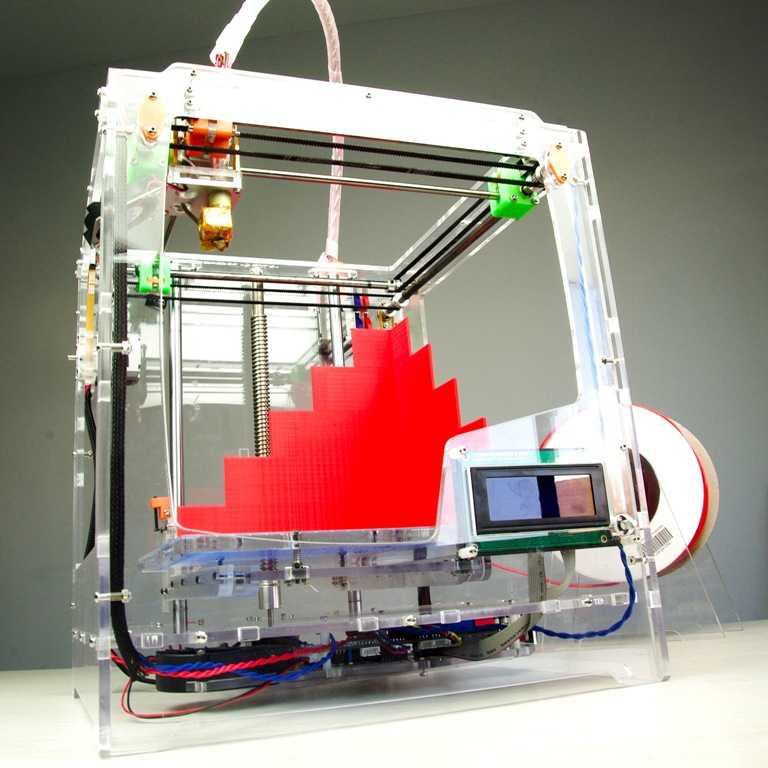
High impact polystyrene (HIPS) is used as support polymers. This material is used for printing ABS plastic, PMMA, PET-G. Polyvinyl alcohol PVA (PVOH, PVA or PVAL) is also used as a support polymer, however, due to the water solubility of this polymer, it is more difficult to obtain a thread from it, modification of the standard technology is required.
At the Interplastica-2018 exhibition, work was announced on the synthesis of special grades of structural polymer materials for 3D printers at the Kabardino-Balkarian State University (PSU, PFS, etc.). In the report of KNRTU (Kazan), the topic of using PP filament for 3D printing was mentioned, which is not surprising, since in the Republic of Tatarstan a wide range of PP grades is produced by Nizhnekamskneftekhim PJSC. The problem with polyolefins in printing is associated with poor adhesion to the 3D printer substrate and high shrinkage when cooled.
FDM printing technology is as follows: a polymer thread is fed into a heated head with a controlled temperature, in the head it is heated to a melt state and the resulting thermoplastic modeling material is fed with high precision in thin layers onto the working surface of a 3D printer. The layers are applied on top of each other, joined together and cooled, gradually forming the finished product.
The layers are applied on top of each other, joined together and cooled, gradually forming the finished product.
The diameter of the nozzle through which a thread with a diameter of 3 or more often 1.75 mm is fed is 0.3-0.4 mm in the first case, and 0.1-0.3 mm in the second case. Therefore, the requirements for a polymer thread should be quite stringent in terms of sizing (thickness variation), stability of rheological properties (melt flow), melt purity (presence of impurities or contaminants).
1 shows the scheme of printing polymer thread FDM
1. Flow chart of 3D printing by FDM polymer filament printing.
The production of thread (rod) for FDM technology is carried out on extrusion plants for extruding rod, including a dryer, an extruder, usually a single-strand extrusion head, a calibrator (if necessary), a cooling bath, a gauge for the thickness (diameter) of the thread, 2 (rarely 4 -x positional) bar winder on the coil. There is a lot of information on the Internet about homemade filament extruders, as a rule, of low productivity and low quality filament.







